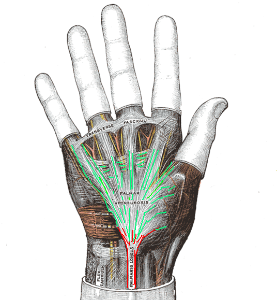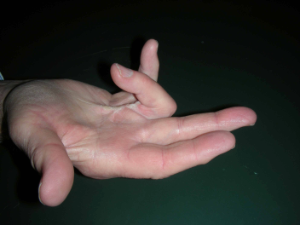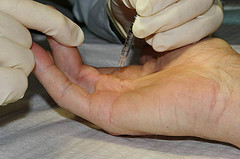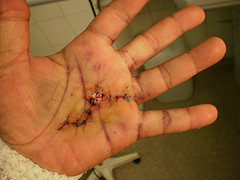9 Dupuytren’s Disease
Dupuytren’s Disease (or simply “Dupuytren’s”) is a progressive disorder characterized by fibrosis of the palmar fascia. Dupuytren’s is associated with the formation of palpable nodules and cords in the palm and fingers. In its later stages Dupuytren’s causes fixed digital flexion contractures. Although the disease process spares the tendons deep to the fascia because the contractures place the finger in flexion (as shown in Figure X ) the tendons cannot function normally. Dupuytren’s Disease usually involves the 4th finger but may include others (the 5th finger is next-most likely to be involved; the thumb is least likely). Dupuytren’s is rarely a painful condition.
Structure and function
Dupuytren’s disease is due to abnormal thickening and contracture of the palmar fascia (also known as the palmar aponeurosis (Figure 1)).

The palmar fascia is a fibrous structure that lies below the dermis and above the flexor tendons and muscles of the hand. It anchors the palmar skin and protects deeper neurovascular structures. The palmar fascia extends from the wrist across the palm (where it is continuous with the transverse carpal ligament); the tendon of the palmaris longus, if present, attaches to it. Distally, it courses into the fingers to become the digital fascia. The fibers of the fascia are architecturally complex, with transverse, longitudinal, or vertical orientations.
In Dupuytren’s disease, these fibers contract to form nodules and then cords. The fascia becomes focally adherent to the overlying skin, causing pitting, and the cords contract, causing fixed flexion deformities of the digits.
The abnormal proliferation of myofibroblasts (specialized fibroblast-like cells that are vital for wound healing) is critical to the pathogenesis of Dupuytren’s disease.
Myofibroblasts, unlike regular fibroblasts, are capable of contracting, and they are responsible for the fascial contraction that is seen in Dupuytren’s Disease. The fascia in Dupuytren’s is characterized by increased numbers of myofibroblasts and inflammatory cells and disorderly collagen deposition. There is increased expression of growth factors within the fascia and an increase in the ratio of type III to type I collagen.
The increased numbers of myofibroblasts, disorderly collagen deposition and increased expression of growth factors seen in Dupuytren’s disease are found in penile fibromatosis (Peyronie’s disease), suggesting a common underlying condition.
The underlying cause of Dupuytren’s remains obscure, but ischemic, autoimmune, and inflammatory mechanisms have all been suggested. Certain environmental factors are thought to play a role, including smoking, alcohol use, and diabetes. It has been suggested but not proven that the use of vibrating machinery may lead to Dupuytren’s.
In addition to environmental factors, there seems to be a genetic basis to at least some cases of Dupuytren’s. This is supported by the large number of patients with a family history of the disorder and by the high prevalence of Dupuytren’s in patients of Northern European descent. An autosomal dominant mode of inheritance with incomplete penetrance has been postulated, but a single gene responsible for the disease has yet to be identified.
Patient presentation
The initial manifestations of Dupuytren’s Disease include thickening of the skin of the hand, and loss of normal skin mobility.
The skin changes are followed by the development of palpable nodules and cords in the palm and fingers. The nodules are usually located near the distal palmar crease, near the base of the finger, or adjacent to the PIP joint.
As the disease progresses, often over a period of several years, flexion contractures of the MCP and PIP joints can develop. These contractures most commonly affect the ring and small fingers (Figure 2).

The “tabletop test” can determine if the patient has a flexion contracture. As shown in Figure 3, the patient here is attempting to lay the hand palm side down, flat on a surface. This test is more sensitive than specific; that is, patients who can lay their hands down do not have a contracture, whereas an inability to do so may have other causes.

In most cases, both hands are involved, although one is often more advanced than the other. Patients may also experience ectopic manifestations, such as fibrosis on the dorsum of the PIP joints (Garrod’s knuckle pads), plantar fibromatosis (Ledderhose disease), penile fibromatosis (Peyronie’s disease), and frozen shoulder.
Objective evidence
In general, Dupuytren’s disease is a clinical diagnosis. Hand x-rays will demonstrate flexion contractures and can be used to rule out other causes of deformity. Nodules and cords will not be seen, as they are radiolucent. While hand x-rays should be obtained at the time of initial evaluation, there is no role for routinely obtaining any other imaging or laboratory studies.
Epidemiology
Typical patients are of Northern European descent, with fair skin and blonde hair. Dark skinned people are not usually affected. It has been suggested that the disease is of Viking origin, although this has not been substantiated. Onset is usually in middle to late life. Dupuytren’s disease is much more common in men than women; and when it is found in women, the onset is later and the disease is less severe.
The prevalence of Dupuytren’s disease varies dramatically by region. It is highest in northern Scotland, Ireland, Norway, and Australia, where as many as 40% of elderly men may be affected. In the United States the prevalence is less than 5%.
Differential diagnosis
While Dupuytren’s disease causes flexion contractures of the digits, a number of other disorders can present in a similar fashion, including stenosing tenosynovitis (or “trigger finger”), ulnar nerve palsy, and camptodactyly.
The thickened skin, nodules, and cords may be confused with scars, calluses, tophi, ganglion cysts, prolapsed flexor tendons (as can be seen in rheumatoid arthritis), or soft tissue tumors such as giant cell tumors or even (rarely) epithelioid sarcomas.
Plantar fibromatosis (Ledderhose disease) and penile fibromatosis (Peyronie’s disease) are sometimes seen in conjunction with Dupuytren’s disease, making thorough history-taking important.
Red flags
Although the signs of early Dupuytren’s can be subtle, pitting of the palmar skin can be one of the first findings and is a relatively specific marker of the disease.
Males with early onset, a family history of Dupuytren’s, ectopic involvement, and bilateral disease have the worst prognosis.
Intervention should be considered when there is a MCP joint contracture of thirty degrees or more or for any degree of PIP joint contracture.
Treatment options and outcomes
Patients with minimal impairment can be educated regarding the diagnosis and observed over time. When symptoms become more severe, intervention is warranted.
Indications for intervention and possible surgical treatment include metacarpophalangeal flexion contractures of more than thirty degrees or any proximal interphalangeal flexion contracture. Once this degree of contracture is present, treatment involves removing or breaking apart the cords that pull the fingers into flexion.
One method for removing or breaking apart the cords that pull the fingers into flexion is to cut them with a scalpel or percutaneously with a needle. This latter technique is called “needle aponeurotomy” or “needling.” The scalpel or needle disrupts or “breaks” the cord of tissue that is contracting the finger. The advantages of this technique are that there is a small or no incision, it can be performed on multiple fingers at the same setting, and usually requires little therapy after the procedure. The primary risk is accidental injury to nerves or tendons.
Another treatment option for breaking apart the cords is the injection of collagenase clostridium histolyticum, an enzyme that weakens the Dupuytren’s cord (Figure 4). This injection is performed in the office. On the day following the injection, the physician manipulates the contracted finger in an attempt to break the cord and straighten the finger. Currently, the collagenase injection can be used on only one joint (in one finger) at a time and additional injections must be spaced at least one month apart. Otherwise, the risks and benefits are similar to those for needling.

Limited fasciectomy (fascial excision) may be performed for more advanced cases. The principle advantage to fasciectomy is a more complete and reliable joint release than that with the needle or enzyme techniques. Disadvantages include the need for hand therapy postoperatively and longer recovery time.

For the most severe and for recurrent cases, the overlying skin must be excised as well and the area skin grafted (a so-called dermo-fasciectomy). Patients are often especially stiff after dermo-fasciectomy. To assist in regaining range of motion, patients are prescribed hand therapy and often thermoplast splints. For more severe stiffness, temporary placement of skeletal traction devices, surgical release of joint contractures, or even joint fusions can be utilized.
Unfortunately, recurrence rates after surgery are high, ranging from 2% to 60% (average 33%). Recurrence may be due to the formation of new nodules at the surgical site or extension of those outside that area.
Potential complications of surgery include skin necrosis, infection, nerve or vascular injury, reflex sympathetic dystrophy, loss of the involved digit, and stiffness.
The outcomes of collagenase injections have been less well-studied. They seem to be effective in the short term and appear relatively safe, although some cases of iatrogenic tendon ruptures have been observed and long-term follow-up is not yet available.
Risk factors and prevention
Risk factors include a family history, male sex, smoking, alcohol intake, and diabetes. Epilepsy, anticonvulsant use, hand trauma, and the use of vibrating machinery may also put patients at higher risk, although this is controversial.
Miscellany
Among bagpipe players, Dupuytren’s Disease is known as the “Curse of the MacCrimmons,” after a family of preeminent bagpipe players in 16th century Scotland. When affected by the Curse, a player’s small finger becomes bent, making bagpipe playing impossible.
Famous sufferers of Dupuytren’s disease include Ronald Reagan, Bob Dole, and Samuel Beckett.
According to Stigler’s (tongue in cheek) Law of Eponymy, “No scientific discovery is named after its original discoverer” (a phenomenon first described by Merton, Stigler points out). Dupuytren’s Disease is no exception: Baron Guillaume Dupuytren’s 1831 lecture associated his name with a condition Henry Cline characterized in 1808.
Key terms
Dupuytren’s disease, palmar fascia, Dupuytren’s diathesis
Skills
Recognize the presenting features of Dupuytren’s disease; Understand the underlying pathophysiology; Identify risk factors for the development of Dupuytren’s disease; Describe the various treatment options and prognosis.
